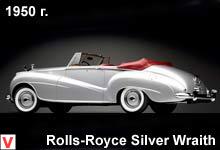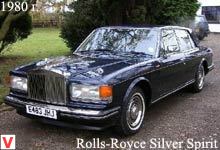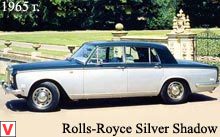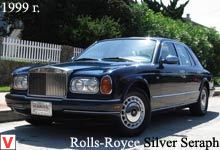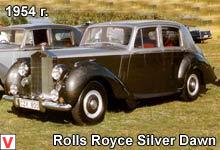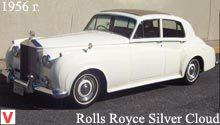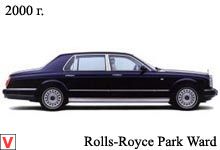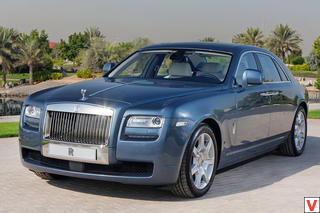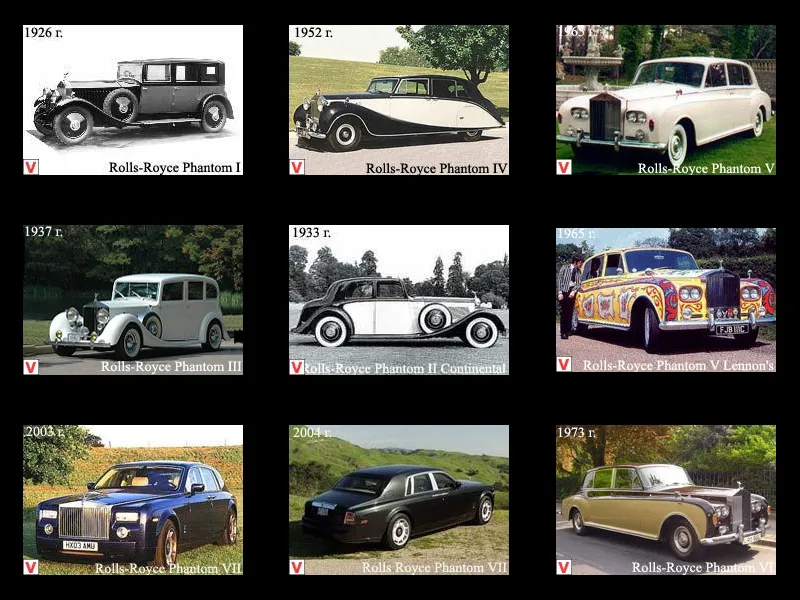
The Phantom series was produced from 1925 to 1968. Phantom I (New Phantom) was produced from 1925 to 1929. He replaced the Silver Ghost. The exterior and chassis of the model was very similar to its predecessor: the same body firms built the body on the same chassis with the same wheelbase.
Ready-made chassis shipped to the body company, whose body was chosen by the customer. The buyer began negotiations with the body company several months before the chassis itself was ready. From the moment of ordering the car to its receipt, customers had to wait six months to a year. The cost of the car was very expensive (about 2500 f.st.). For this money, the company gave a three-year warranty on the undercarriage.
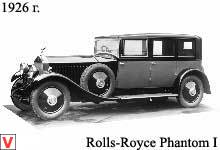
Phantom I was equipped with a 6-cylinder engine with an overhead camshaft displacement of 7.7 liters and a power of 107 hp, which provided high performance. Transmission - manual 4-speed. Maximum speed: 130 km / h. The brake system was included amplifier drive type Hispano-Suiza.
It was the most elegant British car of those years. The model was released in the UK for four years. She did not have much success because of the old-fashioned design and not enough good handling. As a result, in 1929 it was replaced by Rolls-Royce Phantom II. In the USA, the assembly in the Springfield plant was carried out until 1931. In total, 2,212 chassis were manufactured in Derby. 1225 chassis assembled in the United States.
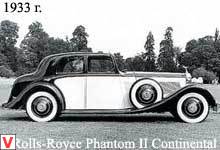
Phantom II continued bodybuilding traditions inherent in the Phantom I, but received an improved suspension system. In comparison with the previous model, the car received a completely new chassis, combined with a 7.7-liter engine on elastic supports a synchronized gearbox and shock absorbers adjustable from the driver's seat. With the same engine power, the car was lighter and had better handling. By the way, the engine "Straight 6", in contrast to the Phantom I, was considered more modern: it had six cylinders, which were installed in rows in two blocks of three cylinders and one aluminum head in each, with a top-mounted valve mechanism - and developed about 100 120 horsepower.
The maximum speed is 145 km / h. The car had a single-plate dry clutch and a hemispherical suspension of flat springs in front and behind. This model had a completely new frame with a stable axle suspension and semi-elliptical springs. The base of the Phantom II was 150 inches (3.81 meters).
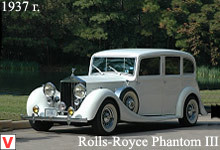
The body design basically repeated the style of the late 20s. The famous radiator has been preserved, but the lines of the wings have become smoother. Rounded shape of the rear of the body. It was a typical Rolls-Royce with an even greater amount of gloss, spaciousness, power and prestige.
Phantom II was the last Rolls-Royce model developed with the participation of Sir Henry Royce, who died in 1933. On the basis of the Phantom II model from 1932 to 1935, a modification of Continental was produced, with the same engine, but shortened to 144 inches (3.65 meters) with a base, a reduced transmission gear ratio, a stiffer suspension, and a smaller weight of 2.49 tons. In addition, body firms installed on these versions more "sports" 4-seater body.
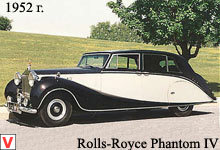
Accordingly, with the same engine power, Continental also had better handling. In 1935, Rolls-Royce Phantom III was introduced at the London Motor Show. The car has become a little bigger, heavier and more expensive than its predecessor, while it is noticeably quieter and outwardly restrained.
The basis of the whole structure, as in previous models, was a steel frame. Phantom III had a very spacious body. The wheelbase of at least 3.6 m and the rear wheel track of 1.55 m provided a huge space for the rear seats, where wealthy owners were located, of whom almost no one tried to drive his car. The car was equipped with a new power unit. It was a V-shaped 12-cylinder engine with a displacement of 7338 cm ³, equipped with a central camshaft, top-mounted valves and hydro-sensors in their drive, dual ignition system and sleeves of "wet" type. Motor power, according to estimates, was 165 hp The maximum speed is 148 km / h. Average fuel consumption of about 28 l / 100km.

The model was equipped with a four-speed manual gearbox, in which only the first gear is not synchronized. Phantom III has become the most technically challenging Rolls-Royce ever produced and the most unreliable. It was the new engine that became the problematic link in the design of the car. Lubricators, which were supposed to improve engine performance, stubbornly clogged with impurities contained in the engine oil, causing periodic disruptions in its work. Another constructive novelty applied on the Phantom III, to which, by the way, there were no complaints, was the front independent lever type suspension, which was controlled by coil springs and hydraulic shock absorbers.
Rear suspension remained dependent and spring. The cost of a car with a gorgeous body work Vaden Plast, Hooper or Thrupp and Maberley could reach up to 2500 - 2800 pounds sterling. Plus huge operating costs, owning such a machine was incredibly prestigious. Production of Rolls-Royce Phantom III continued until 1939, and with the beginning of the Second World War, the production of cars was stopped. A total of 727 copies were produced. Phantom IV was built only for royal persons and heads of state. A total of 18 cars were produced from 1950 to 1956. Nine bodies for the Phantom IV were manufactured by Mulliner Park Ward and seven by Hooper.
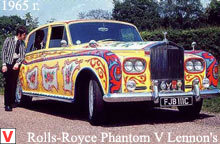
The body of each car had its own style and finish. With the exception of the suspension and transmission, everything in it was original, never used on other Rolls-Royce models. The massive chassis with an X-shaped amplifier in the middle part was further strengthened, the wheelbase was extended to 145 inches (3683 mm). An 8-cylinder in-line engine with a capacity of 5.675 cm³ was installed on the chassis, which received the in-plant designation B80. From the previously released units, the new engine was distinguished by an aluminum head, a single casting of the crankcase and block, upper intake and side exhaust valves.
The torque was transmitted through a dry single-plate clutch and a four-speed manual transmission with synchronizers in the three upper gears. Later it was replaced by “automatic”. Regarding the engine power, the company kept the traditional silence, but it was more than enough to accelerate a car weighing 2.25 tons to 160 km / h. However, the Phantom IV’s ability to trudge at pedestrian speeds without overheating the engine was much more important.
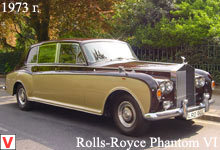
It helped a reliable cooling system. Phantom V debuted in 1959. It was even bigger, heavier and more magnificent than its predecessors, but it retained their elegance, frame layout and the highest quality of manual production. The model was developed on the basis of the Silver Cloud II chassis with the longest wheelbase (3.68 m, like the Phantom IV).
Own car weight, depending on the number of custom equipment reached 2.7 tons. The Phantom V offered a Rolls-Royce car-friendly driver’s workplace and a huge rear space. The engine is V-shaped 8-cylinder, working volume - 6230 cm ³, power - about 200 hp worked in tandem with an automatic transmission.
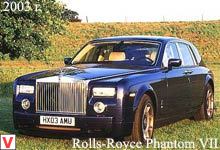
With this power unit, the car developed a maximum speed of more than 160 km / h and consumed a huge amount of gasoline - 28 l / 100 km. One Phantom V in 1962, receiving a snow-white body from the studio Hooper, was sent to the Vatican. The car served the Holy See for 30 years.
The owners of Phantom V were rock musicians Elvis Presley and John Lennon. The most expensive car in the world with the corresponding status in the hands of John Lennon turned into an artistic canvas: a famous musician painted it in avant-garde style. Since this happened in the sixties, it is easy to guess what kind of outrage this act aroused in a privileged part of English society. At first, the demand for a car was steady, but it gradually began to decline. For nine years, the company has built 832 cars of this model. In 1968, the Phantom VI appeared with an independent spar frame. Mulliner-Park-Ward made a seven-seater body with aluminum door panels, hood and trunk for this model.
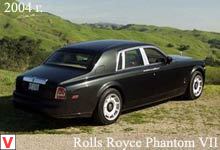
Body type - only limousine or lane. The length of the machine is 6.04 m. The mass in curb condition is 2740 kg. A rich equipment offered air conditioning with two levels (height) climate control. Drum brakes on all wheels.
The first 311 pieces of Phantom VI were released with an upgraded engine from Silver Shadow. In 1978, they began to install a 6.8-liter unit and a 3-speed automatic transmission. Engine power has traditionally not been reported. The maximum speed is 180 km / h. Fuel consumption (urban cycle) - 30.4 l / 100 km. In 1992, the Phantom VI was removed from production.
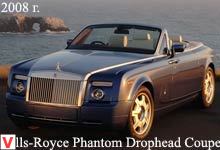
A total of 373 pieces were produced. In 1998, the control of the Rolls-Royce trademark was acquired by the German concern BMW. And five years later, in 2003, the Phantom VII premiered at the Detroit International Motor Show. The car is built on an extended and modified BMW 7 Series platform. Dimensions 5834x1990x1632 mm. Wheelbase 3570 mm. Design features: a monocoque, monocoque, ultra-rigid body of 550 kg, made of aluminum and composite materials; fully independent multi-link suspensions with pneumatic elements and hinged rear doors with powerful electromagnetic locks that automatically operate at a speed of 4 km / h.
Designed by the Phantom VII, the team is led by Ian Cameron and Californian studio BMW. The exterior has preserved the English image and spirit of its legendary ancestors, and, in addition, received high-quality technical stuffing of the Germans. Stylistically, the model is distinguished by a characteristic line of the body, a raised hood and a monumental radiator. The famous figure "Spirit of Ecstasy", if necessary, removes it into a special niche for help electromechanism. The design of the dashboard and the interior is traditional: leather, cashmere and only natural wood are all British-made.
The eye is pleased with the finish of the spokes of the steering wheel, the glove box panel and a number of other interior elements with a walnut tree. In the cabin there is a cupboard for drinks, you can push the TV screen. Devices and ventilation deflectors are enclosed in chrome rims. The lever that switches the modes of "automatic", is located on the steering column. When designing the cabin, the results of large-scale studies were taken into account, which showed that owners of Rolls-Royce cars often do without hired drivers and get behind the wheel themselves. As a result, the Phantom was developed equally convenient for both the driver and passengers.
The wide rear seat is made in the form of two seats with curved, almost vertical backs. Under the hood is a 12.7-cylinder engine of 6.75 liters with the Valvetronic system and 453 hp of direct fuel injection. He works in tandem with the automatic 6-speed gearbox manufactured by ZF. This power unit can accelerate the Phantom VII weighing 2.5 tons to "hundreds" in 5.7 seconds. The maximum speed is 240 km / h. Declared fuel consumption on European standards is 16 l / 100 km. 19-inch Michelin PAX tires with a high profile were developed specifically for Rolls-Royce.
They are created using the latest puncture protection technology and allow you to drive with a punched tire 160 km at a speed of 80 km / h. In 2007, Rolls-Royce unveiled a convertible based on the Phantom VII model. The model was named Phantom Drophead Coupe. The body of the cabriolet is made of aluminum alloy and is a super-rigid spatial farm, on which units and decorative elements are “hung”. The use of such technology has allowed the Phantom Drophead to be the toughest of modern convertibles. All the characteristic elements have been preserved: LED headlights, two-color hood, branded grille, as if integrated into the front, window leaves in front, doors that open against the way.
Like the Phantom VII, the “spirit of ecstasy” figurine is removed under the hood at the touch of a button, and the Rolls-Royce emblem on the wheels does not rotate with them, but is constantly in a “readable” position. The suspension of the car was borrowed from the Phantom VII - independent and pneumatic, active, maintaining a constant ground clearance and preventing pecks from the front and rear. The convertible top of the car is made of cloth. The roof is made by multilayer technology, is removed completely by pressing one key and provides excellent noise insulation when closed.
Phantom Drophead Coupe offers 4 full places. The engine is the same 6.75 liter V12 with a total power of 453 horsepower.
